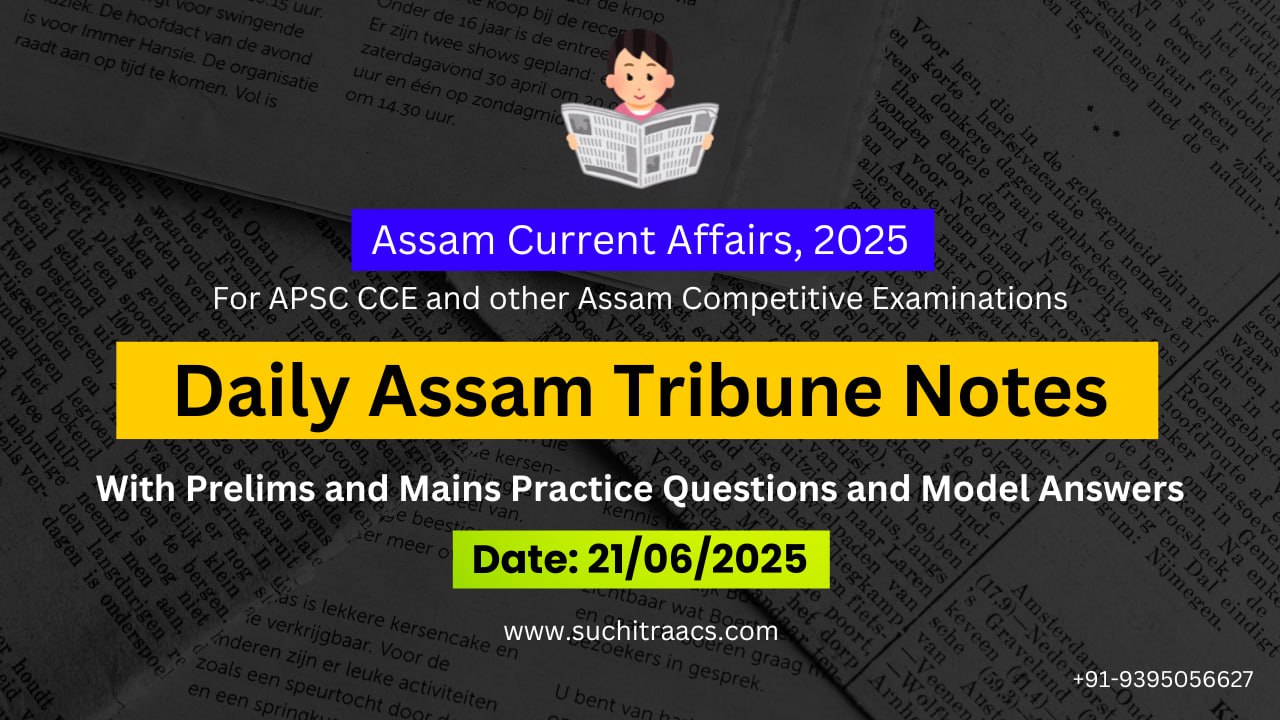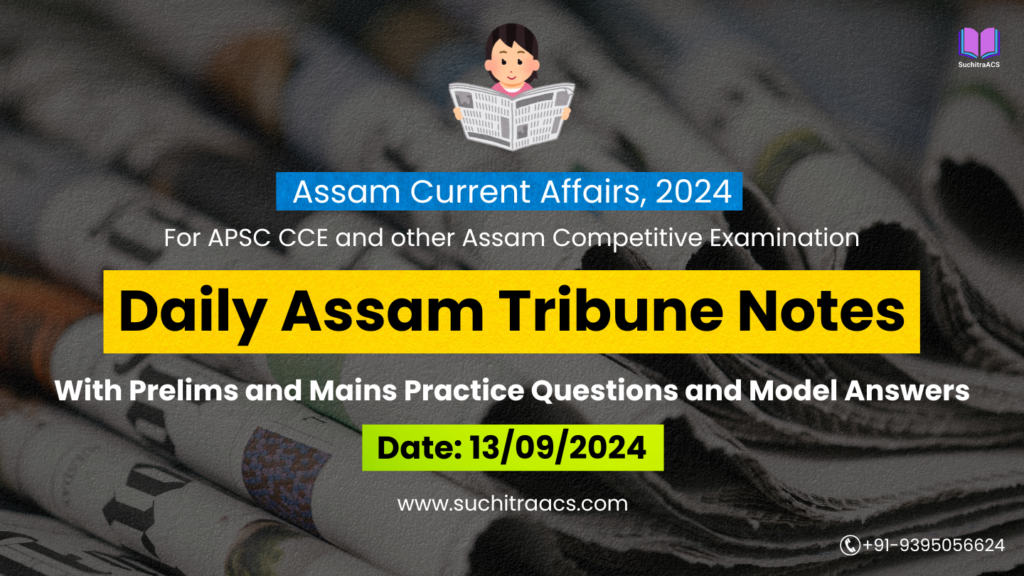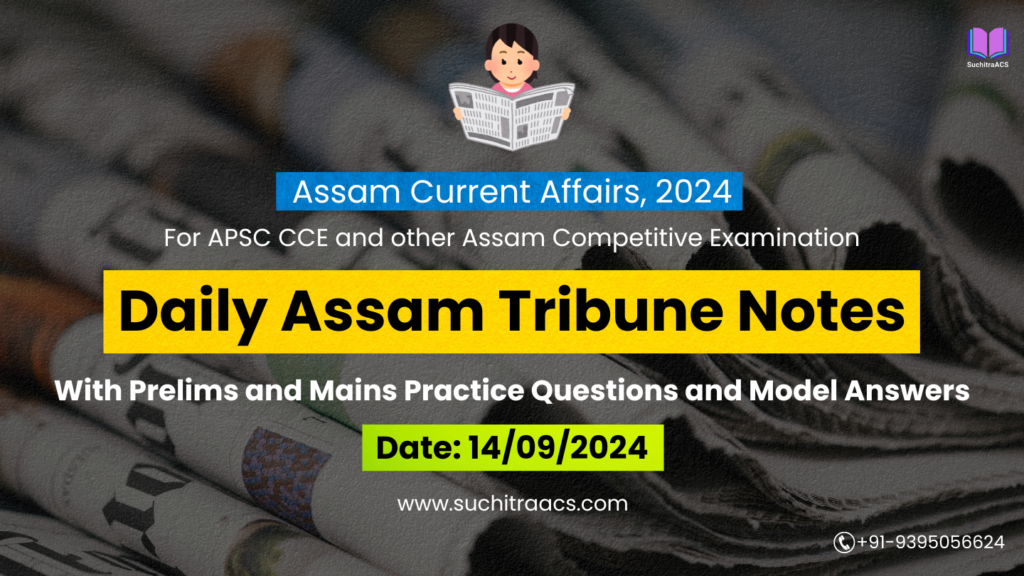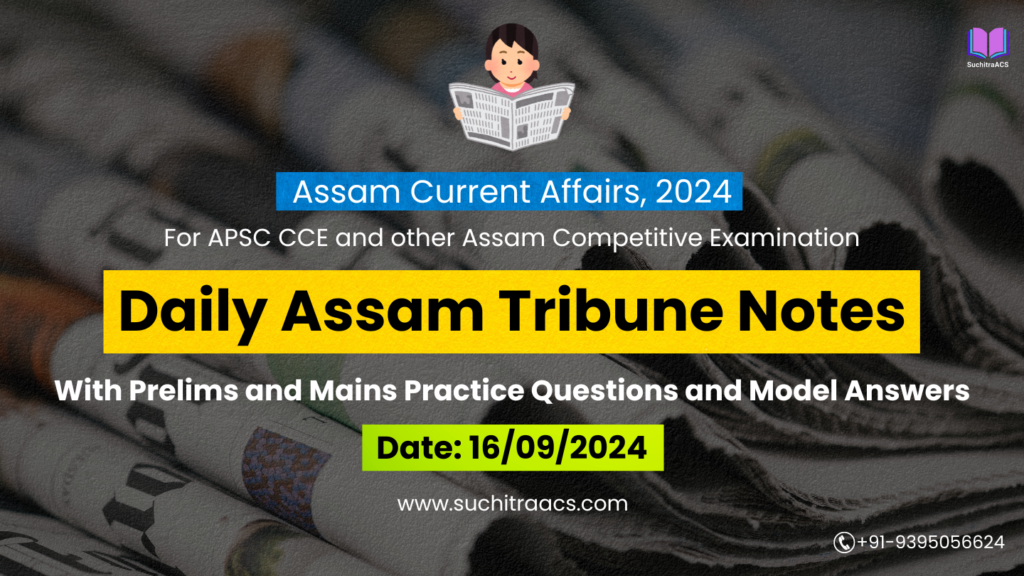APSC Current Affairs: Assam Tribune Notes with MCQs and Answer Writing (21/06/2025)
For APSC CCE and other Assam Competitive examinations aspirants, staying updated with current affairs is vital. This blog covers most important topics from the Assam Tribune today (21-06-2025). These issues are key for both APSC Prelims and Mains preparation, offering insights into the APSC CCE Syllabus.
✨ APSC CCE Online Coaching, 2026
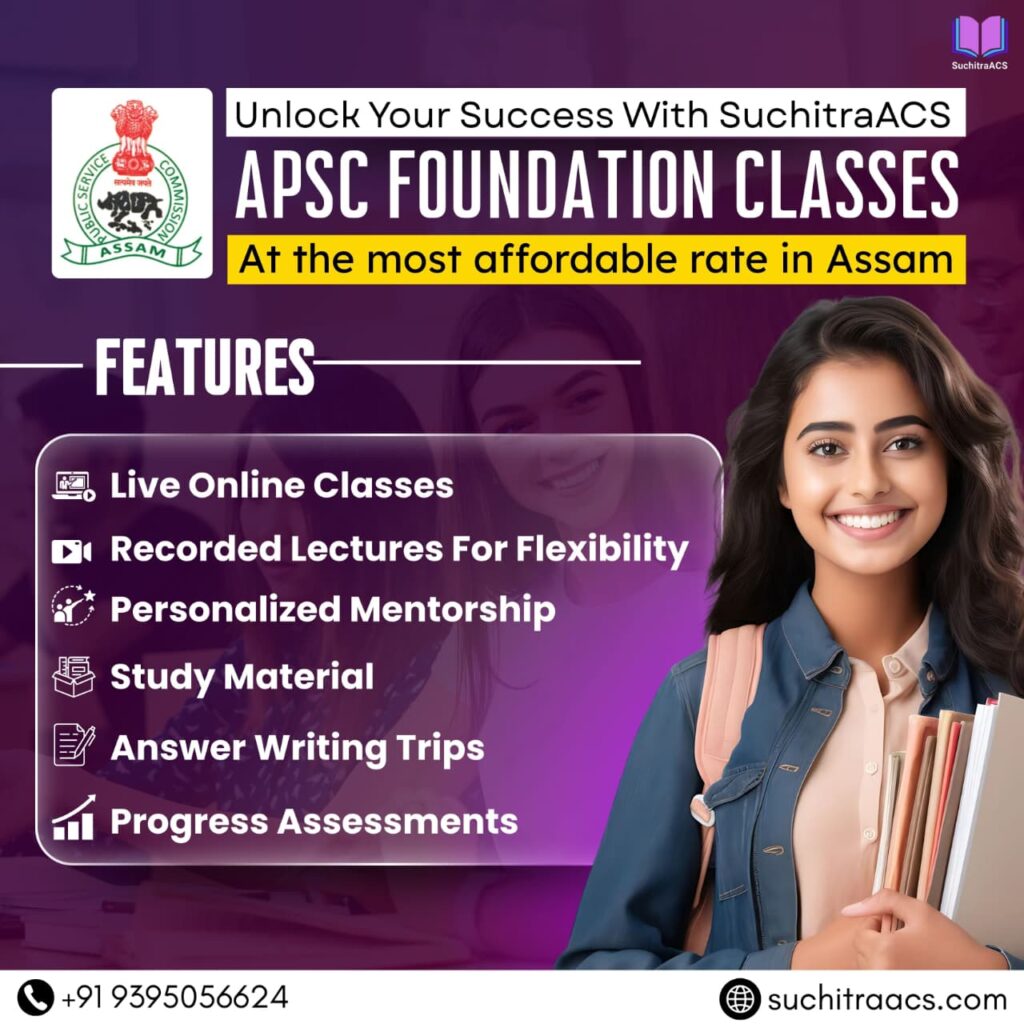
☀️ Rooftop Solar in Assam: Untapped Potential and Employment Opportunity
📘 GS Paper 3: Environment | Renewable Energy | Climate Change
📘 GS Paper 2: Government Policies | Energy Schemes
📘 GS Paper 5 (APSC): Assam – Sustainable Development | Employment Generation
🔹 Introduction
A recent study by the International Forum for Environment, Sustainability and Technology (iFOREST) reveals that Assam’s rooftop solar potential is over 13,400 MW, more than 10 times the current state target of 1,900 MW under the Integrated Clean Energy Policy 2025. If tapped fully, it could generate 1.8 lakh jobs, making it a key solution to Assam’s clean energy and employment goals.
🔑 Key Facts from the Study
| Parameter | Detail |
| 🔋 Total Technical Potential | 13,428 MW (vs 1,900 MW current target) |
| 🏠 Key Concentration | 95% in residential and mixed-use rooftops |
| 🌍 Study by | iFOREST with APDCL’s support |
| 🏙️ Highest Potential Area | Guwahati (625–984 MW) – Lokhra, Sarusajai, Barsajai, Sawkuchi |
| 👷 Employment Potential | 1.8 lakh jobs (installation, maintenance, manufacturing) |
| 📡 Methodology Used | Satellite imagery + ward-level mapping + stakeholder input |
🧠 Prelims Pointers
iFOREST: Independent non-profit working on environmental and energy research
APDCL: Assam Power Distribution Company Ltd – nodal rooftop agency
PM Surya Ghar Yojana: Central scheme providing subsidies for residential solar rooftops
Solar Job Multiplier: ~14 jobs per MW capacity installed (as per MNRE norms)
Climate Vulnerability Index: Assam is among India’s most climate-vulnerable states
📝 Mains Pointers
A. Significance for Assam
Reduces dependence on thermal power and oil imports
Boosts rural and semi-urban energy resilience
Saves electricity bills for households and government buildings
Empowers decentralized energy access
Fits into Assam’s State Action Plan on Climate Change (SAPCC)
B. Challenges to Rooftop Solar in Assam
| Challenge | Explanation |
| 💸 High Upfront Cost | Even with subsidies, capital investment remains a barrier |
| 🤝 Vendor Shortage | Fewer skilled technicians and accredited installers |
| 🏦 Loan Bottlenecks | Banks delay or hesitate in sanctioning rooftop loans |
| 🔌 Grid Compatibility | Issues with net metering and DISCOM infrastructure |
| 📣 Lack of Awareness | Many citizens unaware of subsidies and long-term savings |
C. Policy & Institutional Initiatives
Integrated Clean Energy Policy (Assam) – targets 1,900 MW by 2030
PM Surya Ghar: Muft Bijli Yojana – launched 2024, up to ₹78,000 subsidy
APDCL’s Digital Push – Online approval and vendor empanelment
ACCMS (Assam Climate Change Management Society) – coordinates climate projects
🧭 Way Forward
| Recommendation | Strategy |
| 🎯 Target Revision | Revise target to at least 5,000 MW to align with technical potential |
| 📚 Rooftop Awareness Campaigns | District-level IEC drives in Assamese/Bodo |
| 💰 Green Financing | Solar-specific credit products through NABARD, cooperative banks |
| 👷 Skilling & Employment | Solar training centres under Skill India – focus on rural youth |
| 🔧 Smart Integration | Net-metering, AI-based tracking, and energy storage expansion |
🧩 Conclusion
Rooftop solar is Assam’s low-hanging fruit in its climate and energy journey. Its land-neutral design, high employment yield, and environmental sustainability make it a critical lever for inclusive development. With the right policy push, capacity building, and financing models, Assam can transform into a clean energy leader in the Northeast.
🎓 Cotton University Introduces Courses on Artificial Intelligence (AI) and Cybersecurity
📘 GS Paper 3: Science & Technology – Emerging Technologies | Cybersecurity
📘 GS Paper 2: Education | Skill Development
📘 GS Paper 5 (APSC): Assam – Higher Education | Digital Literacy
🔹 Introduction
In a progressive move aligned with NEP 2020 and digital India goals, Cotton University, Guwahati, has announced the launch of new undergraduate and postgraduate courses in Artificial Intelligence (AI) and Cybersecurity starting from the academic session 2025–26. These programs aim to boost tech capacity and employability among youth in Assam and the Northeast.
🔑 Key Features of the Announcement
| Feature | Description |
| 🏫 Institution | Cotton University, Guwahati |
| 🧠 New Courses Introduced | BSc & MSc in Artificial Intelligence; PG Diploma in Cybersecurity |
| 🧑🏫 Faculty | Industry experts + academic partnership under MoU with tech firms |
| 🗓️ Commencement | From academic year 2025–26 |
| 🖥️ Course Focus Areas | AI ethics, machine learning, data privacy, cryptography, cyber forensics |
| 🤝 Policy Backing | NEP 2020 – focus on digital skilling and flexible curriculum |
🧠 Prelims Pointers
AI: Simulation of human intelligence by machines (learning, reasoning, adapting)
Cybersecurity: Protection of computer systems and networks from theft/damage
NEP 2020: Recommends introduction of emerging tech in curriculum
Digital India FutureLABS: National initiative to build AI skills
IndiaAI Mission (2024): Govt. scheme to develop AI research & education hubs
📝 Mains Pointers
A. Significance for Assam & Northeast
Boosts regional digital skilling and employment
Reduces digital divide between Northeast and metros
Prepares students for 4th Industrial Revolution sectors
Creates home-grown talent for public-sector digital governance
Helps counter rising cases of cyber fraud in the state
B. National and Global Relevance
| Aspect | Significance |
| Start-up Ecosystem | AI is core to fintech, ed-tech, agritech, and logistics start-ups |
| Cyber Sovereignty | India faces over 50,000 cyberattacks monthly – skilled manpower needed |
| G20 AI Cooperation | India is part of global AI ethics and cyber coordination groups |
| Academic Reform | Interdisciplinary AI education matches global trends (e.g., Stanford, IITs) |
C. Challenges in Execution
| Challenge | Explanation |
| 🧑🏫 Faculty Shortage | Limited AI-specialized educators in Northeast |
| 💻 Infrastructure Gap | Labs and GPU-backed systems expensive for public universities |
| 🌐 Industry Exposure | Limited access to live projects and internships |
| 📖 Curriculum Outdated | Need for frequent updates in rapidly evolving tech |
| 🧒 Student Readiness | Gaps in digital foundations from school level |
📑 Relevant Government Programs & Policies
IndiaAI Mission – ₹10,000 Cr initiative under Ministry of Electronics & IT
PMKVY 4.0 – Skill training in AI, data science, cybersecurity
Digital University – Platform to offer AI and cybersecurity courses nationally
Cyber Surakshit Bharat Initiative – Ministry of IT program for digital security training
Assam State Digital Mission – Includes ed-tech and cyber awareness campaigns
🧭 Way Forward
| Recommendation | Strategy |
| 🤝 Academia–Industry Link | MoUs with AI firms, incubators, and national labs |
| 🧪 Practical Exposure | Cyberlabs, hackathons, internships in public & private sectors |
| 📚 Foundational Curriculum | AI readiness from high school level (CBSE/SEBA) |
| 💰 Funding Support | CSR and UGC funding for infra and course material |
| 👥 Inclusive Access | Scholarships for tribal/rural students in tech courses |
🧩 Conclusion
Cotton University’s initiative marks a forward-looking educational reform for Assam. By investing in AI and cybersecurity education, the state can produce a digitally competent, globally relevant, and ethically aware youth force ready for the challenges of tomorrow.
👩⚕️ 40% Shortage of Medical Faculty in Assam: Alarming Gaps in Health Education
📘 GS Paper 2: Health | Education | Governance
📘 GS Paper 5 (APSC): Assam – Public Health | Medical Infrastructure | Human Resource Gaps
🔹 Introduction
A detailed RTI report and official data from the Directorate of Medical Education (DME), Assam, reveal that nearly 40% of teaching posts across Assam’s government medical colleges remain vacant. This faculty crunch severely affects the quality of medical education, MBBS training, PG preparation, and ultimately, public healthcare delivery in the state.
🔑 Key Highlights
| Indicator | Data |
| 🏥 Vacant Faculty Posts | ~1,300 sanctioned posts; ~520 vacant (~40%) |
| 🧑🏫 Highest Vacancy Disciplines | Anatomy, Biochemistry, Pathology, Community Medicine |
| 🏫 Colleges Affected | Guwahati, Silchar, Jorhat, Tezpur, Diphu, Barpeta, Nalbari |
| 📉 Impact | Poor NEET PG coaching, overburdened departments, AIQ seat loss risk |
| 📋 Policy Concern | Despite new medical colleges, recruitment lags due to procedural delays |
| ⚖️ Legal Compliance | Faculty-student ratio non-compliant with NMC norms in some colleges |
🧠 Prelims Pointers
DME Assam: Nodal body for overseeing medical education and faculty in state institutions
NMC: National Medical Commission – sets standards for MBBS/PG education and faculty norms
Assam Health Vision 2030: Targets universal healthcare and regional medical equity
Faculty–Student Ratio (NMC): 1:10 for MBBS; stricter for PG courses
Kayakalp Scheme: Improves quality and infrastructure in public hospitals
📝 Mains Pointers
A. Why Medical Faculty Shortage is a Critical Issue
Hampers quality of medical training and ethical education
Reduces PG eligibility; affects NEET PG and specialty intake
Overburdens existing staff, affecting research and patient care
Weakens Assam’s position as a regional medical hub
Delays recognition of new colleges or increase in seat capacity
B. Structural Challenges
| Issue | Explanation |
| 🕵️♂️ Delayed Recruitment | Lengthy APSC/DME processes with irregular calendar |
| 👩⚕️ Lack of Local Talent | Limited number of postgraduate doctors in certain subjects |
| 📍 Posting Preferences | Urban-centric choices; rural/district colleges left vacant |
| 💸 Salary & Career Stagnation | Private hospitals offer better pay and faster promotions |
| 📚 No Academic Incentives | Low research funding, limited journal recognition |
C. Government Measures So Far
Opening of 8 new medical colleges (Nalbari, Dhubri, Lakhimpur, etc.)
APSC fast-track recruitment announced (2024–25)
Online application portals to speed up joining
MOUs with reputed private hospitals for faculty exchange (limited scale)
Skill-based incentives and academic CME workshops
🧭 Way Forward
| Recommendation | Strategy |
| 🗓️ Yearly Recruitment Calendar | Institutionalised timeline like UPSC exams |
| 🎓 Faculty Development Programs | PG teaching incentives, AIIMS-led faculty training |
| 💼 Incentive-Based Rural Posting | Extra NEET PG marks for rural faculty service |
| 🤝 PPP Models | Use private medical faculty as adjunct professors |
| 📊 Real-Time Vacancy Dashboard | District-wise, subject-wise live tracking and redressal |
🧩 Conclusion
The faculty crisis in Assam’s medical colleges is a human resource emergency in health governance. Bridging this gap requires not just recruitment but a system of incentives, accountability, and institutional reform to ensure that quality healthcare begins in the classroom.
APSC Prelims Practice Questions
✅ Topic 1: Rooftop Solar Potential in Assam
1. According to a recent study by iFOREST, Assam’s rooftop solar potential is:
A. 1,900 MW
B. 5,000 MW
C. 13,400 MW ✅
D. 9,200 MW
🧠 Explanation:
The iFOREST study revealed Assam’s technical rooftop solar potential is over 13,428 MW, far exceeding its current target of 1,900 MW under the state’s clean energy plan.
2. Which of the following correctly pairs the scheme with its benefit?
| Scheme | Benefit |
| 1. PM Surya Ghar Yojana | Rooftop solar subsidy ✅ |
| 2. National Electric Mobility Mission | Rainwater harvesting incentive |
| 3. IndiaAI Mission | Rooftop installation support |
A. 1 only ✅
B. 1 and 3 only
C. 2 and 3 only
D. All of the above
🧠 Explanation:
Only PM Surya Ghar Yojana directly supports rooftop solar installations. The IndiaAI Mission focuses on artificial intelligence, not renewable energy.
✅ Topic 2: AI and Cybersecurity Courses at Cotton University
3. Artificial Intelligence, as introduced in Cotton University’s new courses, typically includes:
- Natural Language Processing
- Machine Learning
- Blockchain Management
- Neural Networks
Select the correct code:
A. 1, 2 and 4 only ✅
B. 2, 3 and 4 only
C. 1 and 3 only
D. All of the above
🧠 Explanation:
AI includes NLP, machine learning, and neural networks. Blockchain is a separate domain, though related in applications.
4. Which of the following national programs promotes cybersecurity awareness and training?
A. Cyber Surakshit Bharat Initiative ✅
B. BharatNet
C. PM Jan Dhan Yojana
D. SATH-E
🧠 Explanation:
Cyber Surakshit Bharat, launched by MeitY, promotes cybersecurity awareness, especially in government and public-sector units.
✅ Topic 3: Shortage of Medical Faculty in Assam
5. As per NMC norms, what is the ideal faculty–student ratio for undergraduate MBBS education?
A. 1:5
B. 1:10 ✅
C. 1:15
D. 1:20
🧠 Explanation:
The National Medical Commission (NMC) mandates a 1:10 teacher-to-student ratio in MBBS programs to ensure quality education and mentorship.
6. Which of the following schemes is directly related to improving infrastructure and quality in public hospitals?
A. Ayushman Bharat
B. NHM
C. Kayakalp Scheme ✅
D. PM Poshan Abhiyaan
🧠 Explanation:
Kayakalp Scheme, launched by MoHFW, aims to improve hygiene, quality, and infrastructure in government health facilities, including medical colleges.
APSC Mains Practice Question
📝 Mains Question:
Q. “Rooftop solar is not only a clean energy solution but a powerful tool for decentralized development.” Examine the potential and challenges of rooftop solar in Assam, and suggest a roadmap to scale it effectively.
📘 Model Answer
Introduction
As India aims for net zero emissions by 2070, decentralized renewable energy solutions are gaining prominence. Rooftop solar (RTS) is one such solution, especially critical for a land-constrained, climate-vulnerable state like Assam. A 2025 study by iFOREST revealed Assam’s RTS potential to be 13,428 MW, which could generate over 1.8 lakh jobs and help meet both climate and livelihood goals.
Significance of Rooftop Solar in Assam
| Area | Benefit |
| 🌱 Environmental | Reduces dependence on fossil fuels, mitigates climate change |
| ⚡ Energy Access | Provides reliable power to rural and urban households |
| 👷 Employment | Estimated 14 direct jobs per MW – high labour intensity |
| 🏘️ Urban Sustainability | Uses idle roof space, reduces peak load on grid |
| 🏛️ Fiscal Relief | Cuts power subsidy burden on state exchequer |
Major Challenges in Scaling RTS in Assam
| Challenge | Explanation |
| 💸 High Upfront Cost | Despite subsidies, initial investment remains unaffordable for many |
| 📡 Grid Integration | DISCOMs face issues with net-metering and bidirectional flows |
| 👷 Skilled Workforce Shortage | Few trained technicians in rural areas |
| 📣 Low Awareness | Citizens unaware of financial and environmental benefits |
| 🏦 Financing Bottlenecks | Limited access to green loans, high interest rates |
Government Initiatives
- PM Surya Ghar: Muft Bijli Yojana – Central subsidy up to ₹78,000 for residential RTS
- Integrated Clean Energy Policy, Assam (2025) – Targets 1,900 MW by 2030
- State Action Plan on Climate Change (SAPCC) – Focus on decentralized energy
- APDCL’s online RTS portal – Simplified application and vendor empanelment
- Skill India Mission – Solar technician training in ITIs (limited implementation)
Way Forward: A 5-Step Roadmap
| Step | Action Point |
| 1️⃣ Policy Revision | Scale up state RTS target to 5,000 MW by 2030 |
| 2️⃣ Finance Innovation | Solar-specific loan products via NABARD, cooperative banks |
| 3️⃣ Awareness Campaigns | Village-level IEC using vernacular mediums (Assamese/Bodo) |
| 4️⃣ Workforce Skilling | Create solar training hubs in Barpeta, Silchar, and Dibrugarh |
| 5️⃣ Smart Net-Metering | Upgrade DISCOM infra with AI-based energy management tools |
Conclusion
Rooftop solar can serve as a triple dividend opportunity for Assam – reducing emissions, creating jobs, and improving energy access. Realizing its potential will require political will, people’s participation, and private sector innovation. If done right, Assam can become a model for decentralized clean energy leadership in India’s Northeast.
✨ APSC CCE Courses, 2025-26 offered by SuchitraACS
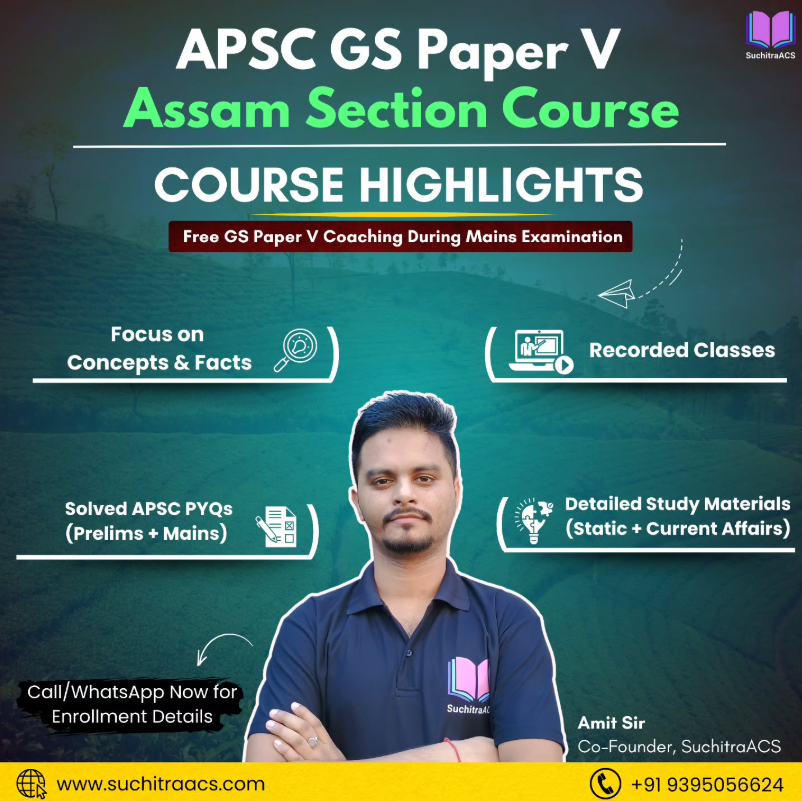

🔔 Join Our WhatsApp Study Group!
For exclusive access to premium quality content, including study materials, current affairs, MCQs, and model answers for APSC CCE and other Assam competitive exams.
Click here to join: SuchitraACS Study WhatsApp Group
📚 Want to know more about SuchitraACS’s most affordable courses?
Click here to know more: SuchitraACS Courses for APSC CCE and Assam Competitive Examinations

